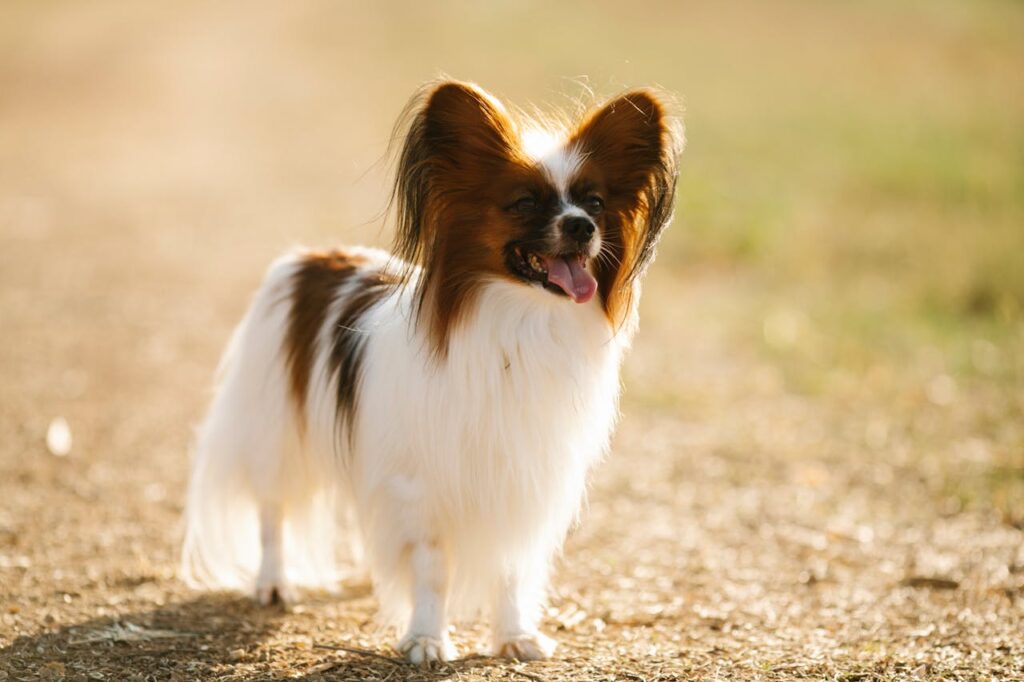Papillons, with their enchanting butterfly-like ears, never fail to captivate those who encounter them. Their name, “Papillon,” comes from the French word for butterfly, perfectly reflecting their elegant appearance.
However, Papillons are much more than their charming looks—they carry a fascinating history, boundless energy, and remarkable intelligence.
Let’s embark on a journey to explore their origins, evolution, and the answer to the question: what were Papillons bred for?
Noble Beginnings of Papillons
For over 500 years, Papillons have graced human lives as cherished companions. These dogs are thought to have originated in Western Europe, descending from the Continental Toy Spaniel.
Artistic depictions dating back to the 12th and 13th centuries, especially in works by Italian painters such as Titian, often feature small spaniels that bear a striking resemblance to Papillons.
While some believe these dogs might have first been bred in Italy, others suggest Spain, leaving their precise origin shrouded in mystery.
Despite their uncertain beginnings, one thing remains clear: Papillons quickly became a symbol of wealth and sophistication.
Their association with royalty and nobility set them apart as dogs bred not for work, but for companionship and status.

What Were Papillons Bred For?
Papillons were purposefully bred as companion animals for the European elite. These petite dogs symbolized affluence, often seen accompanying noblewomen and adorning the laps of aristocrats.
Their affectionate nature and compact size made them ideal as lapdogs, and their warmth was even believed to have healing properties.
Doctors of the time frequently recommended Papillons to their wealthy patients, claiming the dogs could alleviate ailments by providing physical comfort.
Interestingly, the breed developed two distinct ear types over time. The Phalène variety, named after the French word for moth, had drooping ears resembling a moth’s folded wings.
In contrast, the Papillon variety showcased upright ears, resembling butterfly wings. Both ear types remain present in modern litters, emphasizing their shared ancestry.
Papillons and Royalty
During the reign of King Louis XIV, Papillons gained widespread fame. French breeders refined their appearance, enhancing their appeal as regal companions.
One of the most famous Papillon enthusiasts was Queen Marie Antoinette, who adored her dog, Coco. Legend has it that Coco stayed by her side even during her final moments.
After the Queen’s death, Coco lived a long and cherished life, cared for in what is now called “The House of Papillon.”
By the late 17th century, Papillons began to transition from exclusive royal pets to beloved companions for the growing middle class.
Despite this shift, their reputation as symbols of elegance and refinement endured.

Papillons Cross the Ocean
In the late 19th century, Papillons made their way to America, where they quickly gained popularity.
Their charm, intelligence, and spirited nature captivated dog lovers. By 1935, the American Kennel Club (AKC) recognized Papillons as an official toy breed, and the Papillon Club of America was established. These milestones solidified their status as a favorite among dog enthusiasts.
Interestingly, while the AKC recognizes Papillons and Phalènes as a single breed, some European organizations classify them separately.
Despite minor variations in classification, the breed’s enduring appeal remains consistent worldwide.
Even today, Papillons rank among the top 30% of popular dog breeds, a testament to their timeless allure.
you may also like to read: Are Dogs Allowed in Myrtle Beach
Modern-Day Papillons: Small but Mighty
Papillons may be small, weighing just 4 to 9 pounds, but their personalities are anything but tiny. These dogs are fearless, intelligent, and full of life.
Their alertness and agility make them natural performers in canine sports like agility trials, obedience competitions, and even trick training.
Papillons thrive on mental and physical stimulation, making them excellent companions for active households.
These affectionate dogs form deep bonds with their families. They love attention and can struggle in environments where they are ignored or left alone for extended periods.
Papillons are best suited for homes with older children who understand their delicate size.
While they generally get along with other pets, their bold demeanor often leads them to assert dominance, even over much larger dogs.

The Evolution of Their Appearance
Papillons have undergone notable changes over the centuries. Early representations of the breed often depicted dogs with drooping ears, similar to the modern-day Phalène.
The transition to erect ears, characteristic of Papillons, likely occurred in the 17th century, though the exact cause remains uncertain.
Some experts attribute this change to natural mutations rather than intentional breeding practices.
Today, both ear types coexist within the breed, reflecting its rich history and genetic diversity. This duality adds to the breed’s charm and ensures that every Papillon litter carries a connection to its historical roots.
Conclusion
Papillons have come a long way from their origins as noble companions in European courts. Their butterfly-like ears, boundless energy, and affectionate nature make them a beloved breed worldwide.
Understanding what Papillons were bred for offers a glimpse into their enduring charm and the qualities that make them such extraordinary companions.
Whether you’re drawn to their regal history, captivated by their intelligence, or simply enchanted by their appearance, Papillons are sure to win your heart.
Adopting a Papillon means welcoming a lively, devoted, and spirited member into your family one who will undoubtedly brighten your life for years to come.


Pingback: 12 Amazing Benefits of Traveling With Dogs and How to Make It Safe - Tech Promot
Pingback: The Amazing Benefits of Taking Dogs to the Beach - Tech Promot
Pingback: Are Golden Retrievers Double Coated? Lets explore - Tech Promot